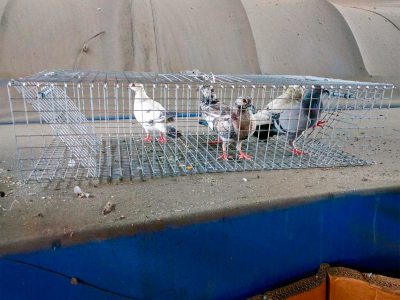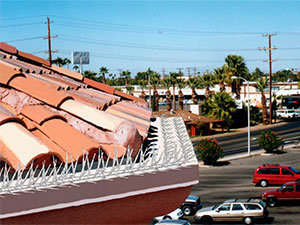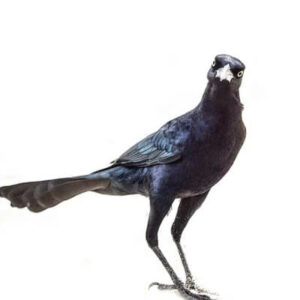Pigeons may look cute in parks, but when they take up residence on your property, they quickly become a nuisance. Their droppings damage buildings, vehicles, and vegetation while potentially spreading disease. This comprehensive guide covers everything you need to know about effective pigeon control – from understanding why these birds are problematic to selecting the right traps and deterrents for your specific situation. We’ll explore both DIY approaches and professional solutions to teach you how to get rid of pigeons.
Quick Picks: Best Pigeon Control Products for 2025
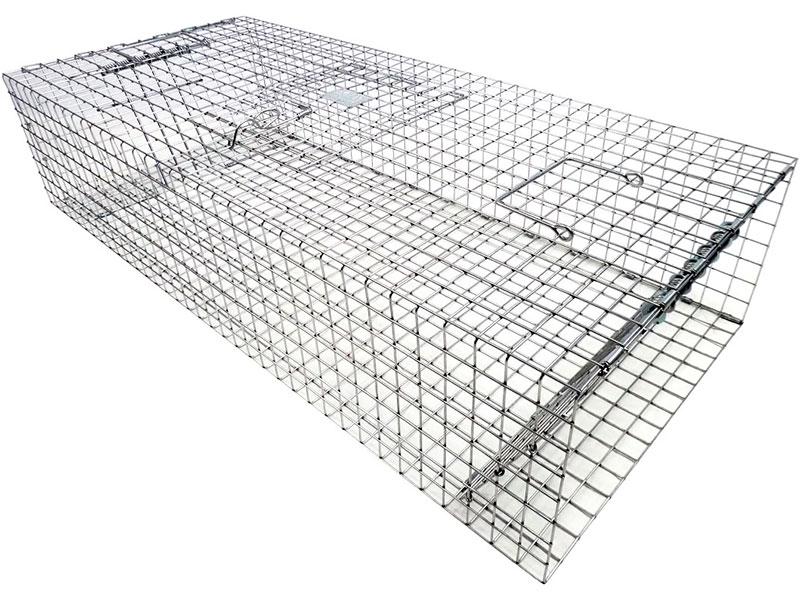
Best Overall
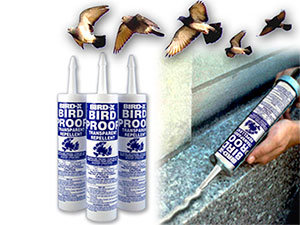
Best Repellent

Budget Pick
- Pigeon Problems: Why These Birds Can Be Dangerous
- Proactive Prevention: Stop Pigeons Before They Settle In
- How to Get Rid of Pigeons: Deterrents That Actually Work
- Trapping Solutions: How to Catch Pigeons Humanely
- Seasonal Pigeon Control Guide
- DIY vs. Professional Pigeon Control Solutions
- Long-Term Maintenance Plan
- Choosing the Right Pigeon Control Method: Your 2025 Buyer’s Guide
- Legal Considerations for Pigeon Control
- Regional Pigeon Control Considerations
- Humane Control: Moving Beyond Lethal Methods
- Frequently Asked Questions About Pigeon Control
- Conclusion: Creating an Effective Pigeon Management Strategy
Pigeon Problems: Why These Birds Can Be Dangerous
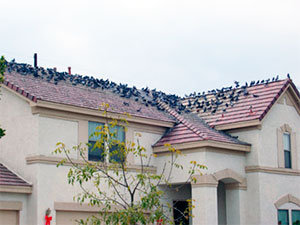 Pigeons might seem harmless, but when present in large numbers, they create significant problems for property owners. Their droppings are particularly problematic as they can:
Pigeons might seem harmless, but when present in large numbers, they create significant problems for property owners. Their droppings are particularly problematic as they can:
- Damage vegetation, cars, buildings, and outdoor furniture
- Create persistent unpleasant odors
- Block vents and downspouts when combined with nesting materials
- Potentially spread fungal diseases harmful to humans
- Attract parasites and mites to your property
Pigeons adapt easily to urban environments, making them difficult to discourage once they’ve established a presence. They evolved from cliff-dwelling birds, which is why they’re so comfortable nesting on the ledges, eaves, and rooftops of our buildings – these structures closely resemble their natural habitats.
Health Risks
Pigeon droppings can harbor fungal spores that cause histoplasmosis, cryptococcosis, and psittacosis when inhaled by humans.
Property Damage
The acidic nature of pigeon droppings can corrode metal, stonework, and paint over time, leading to expensive repairs.
Financial Impact
Ongoing pigeon issues can decrease property values and require regular cleaning and maintenance.
Proactive Prevention: Stop Pigeons Before They Settle In
The most effective pigeon control strategy is prevention. By making your property less attractive to pigeons, you can avoid many of the challenges of removing an established flock.
Modify Your Home
Start with modifications that make your property less inviting to pigeons:
Block Up Attics
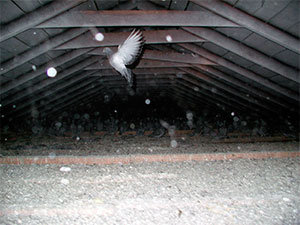 Pigeons commonly seek out attics as nesting sites. Ensure all potential entry points are properly sealed with wire mesh or appropriate materials.
Pigeons commonly seek out attics as nesting sites. Ensure all potential entry points are properly sealed with wire mesh or appropriate materials.
Use Barriers
Physical barriers are highly effective at preventing pigeons from roosting on ledges, air conditioning units, and similar surfaces:
- Install wood or sheet metal blocks at a 60-degree angle on flat surfaces
- Place plastic mesh netting over potential roosting areas
- Install specialized pigeon netting to block indoor nesting areas
How to Get Rid of Pigeons: Deterrents That Actually Work
Once you’ve implemented basic preventative measures, the next step is to actively deter pigeons from your property. Here’s a comprehensive overview of the most effective deterrent products available in 2025: Some popular solutions include bird spikes, which physically prevent pigeons from perching, and reflective surfaces that create an unsettling environment for them. Additionally, using noise deterrents, such as ultrasonic devices, can further discourage their presence. If you’re also wondering how to deter geese effectively, consider incorporating decoys or natural predators into your landscape to make your property less inviting to these birds as well.
Visual Deterrents
Visual deterrents exploit pigeons’ natural fear of predators and unfamiliar moving objects:
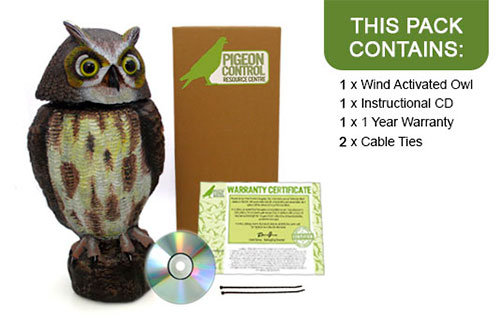
Wind Powered Owl Decoy
- Moving head activates pigeons’ instinctive fear
- More effective than static models
- Works in just the gentlest breeze
- Weather-resistant construction
Reflective and Sound Deterrents
These products use light reflection and noise to create an uncomfortable environment for pigeons:

Bird Repellent Scare Tape
- Creates visual flashes and rustling sounds
- Non-toxic and environmentally friendly
- Easy installation with immediate results
- Set-and-forget solution
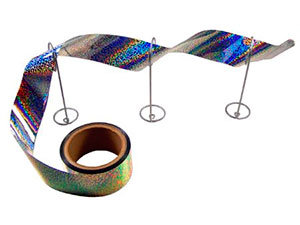
Holographic Scare Ribbon
- Reflective hologram flashes in sunlight
- Weather-resistant material
- 100ft roll covers large areas
- Multiple application methods
Electronic Sonic Repellents
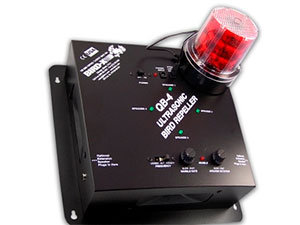
Bird-X QuadBlaster QB-4
- Ultrasonic sound disorients and confuses birds
- Covers up to 6,500 square feet
- Weatherproof for outdoor installation
- Adjustable frequency settings
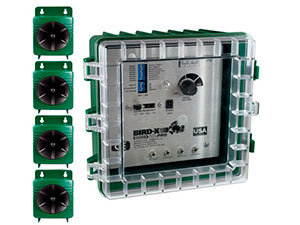
BroadBand PRO with Visuals
- Combines sound with visual deterrents
- Includes three best-selling visual scares
- Comprehensive protection system
- Ideal for large problem areas
Surface Repellent Gels
Repellent gels create a sticky sensation that pigeons dislike. With their sensitive feet, pigeons quickly learn to avoid treated areas:

Bird-X Bird Proof Repellent Gel
- Creates uncomfortable surface for pigeons
- Non-toxic and safe for use around people
- Lasts up to 12 months in most conditions
- Effective on ledges, sills, beams, and rafters

Bird B Gone – Transparent Bird Gel – Bird Repellent Gel
- Clear, odorless gel deters without being visible
- No harmful chemicals or poisons
- Suitable for domestic and commercial use
- Remains effective for up to one year
Physical Deterrent Systems
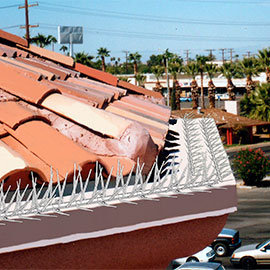
Stainless Steel Bird Spikes
- Prevents birds from landing without harm
- UV-resistant stainless steel construction
- Virtually invisible from ground level
- 10-year lifespan in outdoor conditions
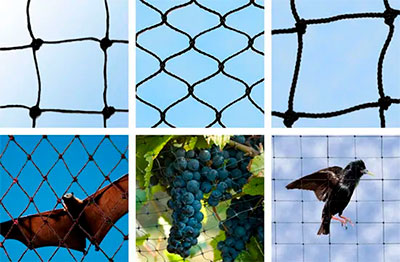
Professional Bird Netting
- Complete exclusion for large areas
- UV-stabilized for long-term outdoor use
- Nearly invisible when properly installed
- Effective for all bird species
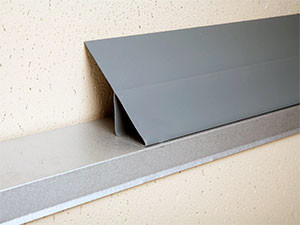
Bird Slope System
- Creates angled surface birds cannot land on
- Blends with architectural features
- No maintenance once installed
- Weather and UV resistant materials
For best results, consider combining multiple deterrent types. Visual deterrents work well initially but may lose effectiveness over time, while physical barriers provide permanent protection. Surface repellents work well for specific problem areas and electronic devices cover larger spaces.
Trapping Solutions: How to Catch Pigeons Humanely
When deterrents aren’t enough, trapping becomes a necessary option. These humane traps allow you to capture pigeons without harming them, so they can be released elsewhere or handled according to local regulations.
Tomahawk Rigid Pigeon Cage Trap
Best OverallHow Does It Work
How to Use
- Place the trap in an open area near the pigeons' roosting site
- Bait the trap with bird seed or bread
- Cover the trap with a tarp or sheet to make it dark and more appealing to the birds
- Check the trap daily and release any captured pigeons according to local regulations
- Holds 15+ pigeons at once
- Easy to set up and use
- Sturdy and durable construction
- Humane capture method
- More expensive than some other options
- The trap is difficult to move around
- Requires regular monitoring
Hunting Humane Live Bird Net Trap
Best Net TrapHow Does It Work
How to Use
- Place the trap in an area with frequent pigeon activity
- Set the trap on level ground for proper triggering
- Connect the metal wire to the loop on top of the trap
- Hang bait on the hook attached to the metal wire
- Check the trap regularly to remove captured birds
- Humane capture method that doesn't stress birds
- Lightweight and portable design
- Can be used for various bird species
- Easy to set up with included instructions
- Only captures one bird at a time
- Requires precise placement for effectiveness
- Requires regular bait replacement
- Less effective in windy conditions
Pigeon Birds T-Trap Door
Best Entry ControlHow Does It Work
How to Use
- Mount the trap door at entry points to your pigeon loft or enclosure
- Ensure the door is securely fastened on all sides
- Adjust according to the included instructions for proper swing tension
- Regularly inspect for proper operation and clean as needed
- Simple installation requires minimal tools
- Durable iron construction for long-term use
- Easy to clean with a simple wipe-down
- No power required for operation
- Limited size options may not fit all applications
- Iron construction can be heavier than aluminum alternatives
- May require occasional adjustment for optimal performance
Seasonal Pigeon Control Guide
Pigeon behavior changes throughout the year, and your control strategies should adapt accordingly. Understanding these seasonal patterns will make your control efforts more effective.
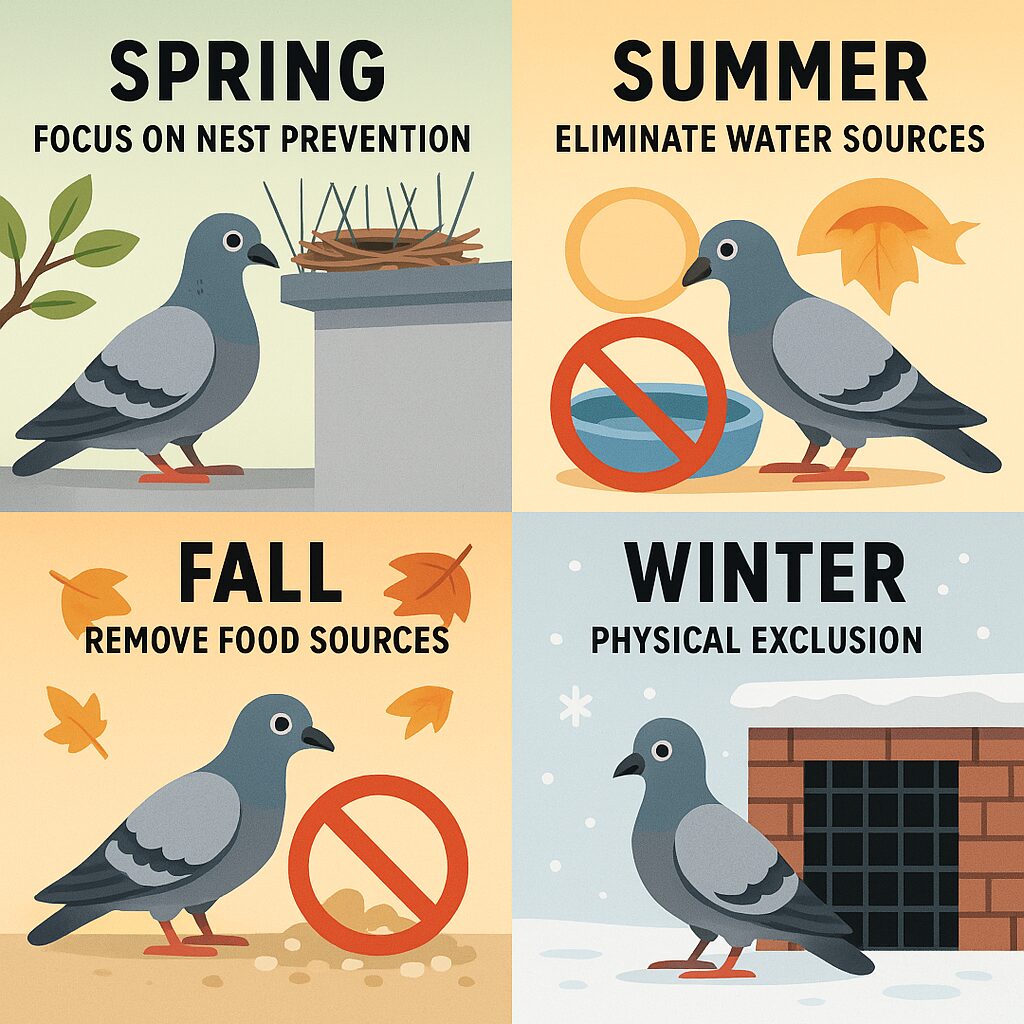
| Season | Pigeon Behavior | Recommended Control Strategies |
|---|---|---|
| Spring (Mar-May) |
Primary breeding season; aggressive nest-building and territorial behavior | Focus on nest prevention; install barriers in potential nesting areas; remove nesting materials promptly |
| Summer (Jun-Aug) |
Continued breeding; increased presence near water sources | Eliminate water sources; maintain deterrents; focus on exclusion methods during early morning/evening hours |
| Fall (Sep-Nov) |
Preparing for winter; increased feeding activity | Remove food sources; seal entry points to buildings before winter roosting begins |
| Winter (Dec-Feb) |
Seeking shelter; congregating in protected areas | Focus on physical exclusion from indoor spaces; maintain deterrents despite reduced activity |
DIY vs. Professional Pigeon Control Solutions
Deciding between handling your pigeon problem yourself or hiring professionals depends on several factors, including the severity of the infestation, your budget, and the size of the affected area.
| Consideration | DIY Approach | Professional Services |
|---|---|---|
| Cost | $50-300 for basic deterrents and traps | $300-1,500 depending on property size and infestation severity |
| Time Investment | Requires personal time for installation, monitoring, and maintenance | Minimal time investment; professionals handle all aspects |
| Effectiveness | Variable depending on consistency and proper implementation | Generally higher success rate; professionals have specialized equipment |
| Best For | Small to medium infestations; accessible areas; budget-conscious homeowners | Large infestations; commercial properties; multi-story buildings; immediate results needed |
When to Call Professionals
Licensed pest control professionals can often access more powerful deterrents not available to the general public and have equipment designed for safe application in difficult areas.
Long-Term Maintenance Plan
Successfully removing pigeons from your property is only half the battle. A comprehensive maintenance plan will prevent them from returning.
Maintenance Schedule
| Time Period | Maintenance Tasks |
|---|---|
| Weekly |
|
| Monthly |
|
| Quarterly |
|
| Annually |
|
Monitoring for Returning Birds
Early detection is crucial for preventing reinfestation. Watch for these warning signs:
- Fresh droppings appearing in previously cleaned areas
- Cooing sounds, especially in early morning hours
- Feathers gathering in protected corners or ledges
- Pigeon sightings during regular daily patterns (indicating habituation)
Choosing the Right Pigeon Control Method: Your 2025 Buyer’s Guide
With so many pigeon control options available, selecting the right approach for your specific situation is important. Consider these factors when making your decision:
| Control Method | Best For | Considerations |
|---|---|---|
| Physical Barriers | Long-term prevention on ledges and small areas | Requires proper installation, can be visually unappealing |
| Visual Deterrents | Low-cost initial deterrence | May become less effective over time as birds acclimate |
| Sonic Devices | Large areas, commercial properties | Higher cost, may affect other wildlife |
| Repellent Gels | Targeted application on specific roosting areas | Requires periodic reapplication, can collect dirt |
| Traps | Immediate removal of problem birds | Requires handling and relocating captured birds |
Factors to Consider When Choosing a Pigeon Control Method
- Size of the affected area – Larger areas may require multiple approaches or professional assistance
- Severity of infestation – Established flocks might require more aggressive measures
- Budget constraints – Options range from inexpensive DIY solutions to costly professional systems
- Environmental considerations – Some methods may impact other wildlife or pets
- Local regulations – Check your area’s rules regarding wildlife management before trapping or relocating pigeons
Legal Considerations for Pigeon Control
Before implementing any pigeon control method, it’s important to understand the legal implications:
Any action taken to control pigeons on a property is the legal responsibility of the owner. Even if you hire a pest control company, as the property owner, you remain legally responsible for all actions taken on your behalf.
Regulations regarding pigeon control vary by location. In general:
- Feral pigeons are not protected in most areas of the United States
- Humane trapping and relocation is typically permitted
- The use of pigeon poisons is strictly regulated and often requires special licensing
- Some municipalities have ordinances against feeding pigeons, which can help control populations
Regional Pigeon Control Considerations
Pigeon control strategies may need to be adjusted based on your climate and local environment. Here’s how regional factors can affect your approach:
Hot, Dry Climates
In areas like the Southwest, focus on water source elimination as pigeons are attracted to any available moisture. Repellent gels may dry out faster, requiring more frequent reapplication.
Cold Climate Concerns
In northern regions, pigeons seek heated spaces during winter. Prioritize sealing entry points to attics and heated buildings. Some deterrents may be less effective in freezing temperatures.
Humid, Rainy Areas
In humid regions, pigeon droppings create more severe health risks due to faster mold growth. Prioritize regular cleaning and use weather-resistant deterrents that won’t be compromised by rainfall.
Urban Settings
In dense urban areas, neighboring buildings may provide alternative roosting sites. Coordinate with neighbors when possible for a more comprehensive approach to control.
Humane Control: Moving Beyond Lethal Methods
Modern pigeon control focuses on humane deterrence rather than lethal methods. Here’s why humane approaches are not only more ethical but often more effective:
With the wide range of effective deterrents and traps available today, lethal control methods are rarely necessary or recommended. Most pigeon problems can be successfully managed with the humane approaches outlined in this guide.
Frequently Asked Questions About Pigeon Control
Is it legal to trap and relocate pigeons?
Generally yes, but regulations vary by location. According to the Internet Center for Wildlife Damage Management, feral pigeons are not protected in most areas of the United States, but you should check with local wildlife authorities before relocating pigeons.
In some areas, you may need to euthanize captured birds humanely rather than release them elsewhere. Always verify local ordinances before implementing any trapping program.
How long do pigeon deterrents typically last?
The durability of different deterrents varies considerably:
- Physical barriers like spikes can last 5-10 years with proper maintenance
- Repellent gels typically need replacement every 6-12 months
- Visual deterrents remain effective longer if regularly repositioned (every 2-3 weeks)
- Electronic devices generally last 3-5 years depending on weather exposure
- Bird netting can last up to 10 years if properly installed and maintained
Research from the University of South Africa study shows that physical barriers like bird spikes were the most effective long-term solution, reducing pigeon populations by nearly 70%.
Will removing nests harm baby pigeons?
Yes, removing active nests with eggs or young birds can cause harm. It’s best to wait until the young have fledged before removing nests, then immediately install deterrents to prevent renesting.
If immediate nest removal is necessary, consult with a wildlife professional who can safely relocate the nest or provide an alternative solution. The BC SPCA AnimalKind recommends humane deterrents as a preferred approach to minimize disruption to existing birds.
Can I use bird feeders if I have a pigeon problem?
Bird feeders often attract pigeons and can worsen existing problems. Consider these options:
- Use specialized feeders designed to exclude larger birds
- Install squirrel/pigeon guards above feeders
- Select seeds that pigeons don’t prefer (safflower or nyjer)
- Temporarily remove all feeders until your pigeon problem is resolved
- Position feeders away from buildings and roosting areas
According to University of Missouri Extension, eliminating feeding opportunities is crucial for long-term pigeon control.
How do I clean pigeon droppings safely?
When cleaning pigeon droppings, follow these safety precautions:
- Wear an N95 respirator mask and disposable gloves
- Moisten droppings first with a disinfectant spray to prevent spores from becoming airborne
- Use a dedicated cleaning solution containing a disinfectant
- Dispose of waste in sealed plastic bags
- Clean all tools with disinfectant after use
For large accumulations or droppings in public areas, consider hiring professionals with proper equipment and training to minimize health risks.
Do ultrasonic repellers actually work on pigeons?
Research indicates that ultrasonic devices are largely ineffective against pigeons. According to the University of Florida, ultrasonic waves reflect off objects, creating “sound shadows” where birds can avoid the sound.
Studies have even documented pigeons nesting directly on top of functioning ultrasonic repellers. More effective alternatives include physical barriers, visual deterrents, or taste repellents that have been scientifically verified to reduce pigeon populations.
What is OvoControl and how does it work?
OvoControl P is an EPA-registered birth control product specifically designed for pigeons. According to OvoControl’s official site, it works by preventing eggs from hatching, effectively reducing pigeon populations by about 50% annually.
The non-toxic bait is fed to pigeons daily, interfering with egg development without harming the birds. This method is endorsed by animal welfare organizations as a humane alternative to lethal control and is particularly effective for large facilities where physical deterrents are impractical.
Conclusion: Creating an Effective Pigeon Management Strategy
Managing pigeon problems requires a strategic approach that often combines multiple methods for the best results:
With patience and the right combination of tools, you can successfully reclaim your property from problematic pigeons. Remember that consistency is key—pigeons are intelligent and adaptable birds that will test your defenses repeatedly.
By understanding the various control options available and applying them appropriately to your specific situation, you can create a pigeon-free environment that protects both your property and your health.
Final Tips for Success
- Rotate visual deterrents regularly to prevent birds from becoming accustomed to them
- Clean areas thoroughly after pigeon removal to eliminate attractants
- Consider professional help for severe or persistent infestations
- Address the problem early—small flocks are easier to discourage than established colonies
- Combine multiple deterrent types for maximum effectiveness
![How to Install Bird Spikes [Pro Tips] A Step-by-Step Tutorial - Bird B Gone](https://pestkill.org/wp-content/cache/flying-press/00a89ad5578471a9a67df3e75e1ea08f.jpg)
